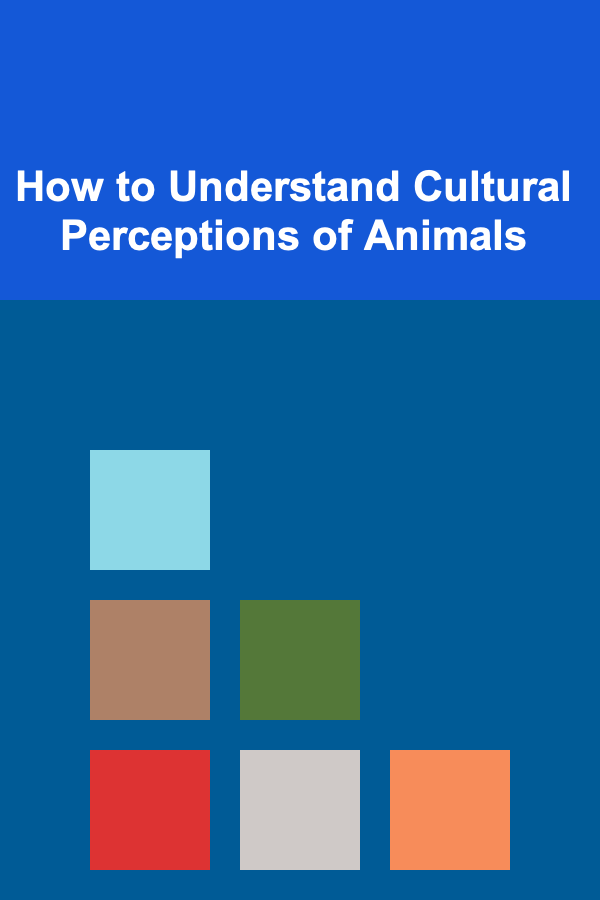
How to Understand Cultural Perceptions of Animals
ebook include PDF & Audio bundle (Micro Guide)
$12.99$9.99
Limited Time Offer! Order within the next:

Animals have long been a central part of human history, appearing in art, literature, religion, and mythology across various cultures. They symbolize a wide range of meanings, from strength and wisdom to innocence and vulnerability. In different societies, animals are interpreted and perceived in unique ways, shaped by historical, environmental, and philosophical factors. Understanding cultural perceptions of animals not only gives us insight into how societies view the natural world but also sheds light on broader human values, social structures, and belief systems. This article delves into how different cultures perceive animals and why those perceptions matter.
The Role of Animals in Human Culture
The relationship between humans and animals is as old as civilization itself. Early humans depended on animals for food, clothing, and labor, and many of these roles still exist today. However, animals have also served as symbols in various cultural contexts. In many ancient societies, animals were deified or revered, and certain animals became integral to religious rituals and myths.
For example, in ancient Egypt, the lion, the cat, and the ibis were sacred animals associated with the gods. The cat, in particular, was associated with the goddess Bastet, who represented protection, fertility, and the home. In Native American cultures, animals are often seen as spirit guides or messengers of the divine. The wolf, eagle, and bear are among the animals revered for their strength, wisdom, and connection to the natural world.
In addition to their symbolic roles, animals also serve as subjects of human storytelling. From Aesop's Fables to contemporary cartoons, animals are frequently anthropomorphized---imbued with human characteristics and personalities. These stories often serve as vehicles for teaching moral lessons, such as the importance of honesty, bravery, or kindness.
How Cultural Context Shapes Animal Perception
Cultural perceptions of animals are not universal; they vary greatly depending on geographical location, historical context, and societal values. For example, in Western cultures, domesticated animals such as cats and dogs are often regarded as family members, whereas in other cultures, the same animals may be seen more utilitarian or even unclean.
The Symbolism of Animals in Religion and Mythology
Religion and mythology have long influenced the perception of animals in different cultures. In many belief systems, animals are associated with deities, spirits, or supernatural forces. These associations often shape how animals are viewed and treated.
In Hinduism, cows are sacred animals and are highly revered. This reverence stems from the cow's association with the goddess Kamadhenu, who is believed to provide nourishment and fulfill desires. As a result, many Hindus refrain from eating beef and take steps to protect cows from harm.
In contrast, in some parts of the world, animals that are associated with gods or divine powers are considered sacred and are often seen as untouchable. For example, the Hindu god Shiva is often depicted with a snake, which is symbolic of power and protection. Snakes are therefore seen as auspicious in certain contexts, and in some cultures, killing a snake is considered a grave offense.
Cultural Differences in Animal Consumption
The consumption of animals is a particularly interesting aspect of how cultures view animals. In many cultures, eating certain animals is seen as a normal part of life, while in others, it is considered taboo. The consumption of beef, for instance, is common in many Western countries but is avoided in Hindu-majority India, where the cow is sacred.
In certain parts of the world, such as parts of Southeast Asia, dog meat is consumed as a delicacy, whereas in other regions, particularly in Western countries, dogs are primarily seen as pets and companions. This cultural difference can sometimes lead to misunderstandings and conflicts between people from different cultures. For example, Western animal rights groups may condemn the practice of eating dog meat in certain countries, while local communities may view it as part of their traditional cuisine and cultural identity.
Attitudes Toward Wild Animals and Conservation
Cultural perceptions also influence how different societies view wildlife and the importance of conservation. In some cultures, wild animals are seen as dangerous and must be controlled, while in others, they are regarded as integral to the ecosystem and deserving of protection.
For instance, in some African cultures, certain animals like elephants, lions, and rhinos are considered symbols of power and prestige. However, due to poaching and habitat destruction, these animals are now endangered. In many Western countries, wildlife conservation efforts focus on protecting endangered species and maintaining biodiversity. In contrast, some indigenous cultures in South America and Australia view wild animals as part of a larger spiritual ecosystem and emphasize living in harmony with nature.
How Animals Are Perceived Through the Lens of Ethics
Ethical considerations play a crucial role in how animals are perceived and treated in different cultures. The development of animal rights movements and the growing awareness of animal welfare have prompted many societies to reconsider their relationships with animals.
Western Views: The Rise of Animal Rights
In Western cultures, particularly in Europe and North America, there has been a significant shift in how animals are perceived over the past century. The rise of animal rights movements has led to changes in legislation and public attitudes regarding animal cruelty, factory farming, and the use of animals in scientific research.
In these societies, there is an increasing recognition of animals as sentient beings deserving of protection from unnecessary harm. This shift has resulted in the banning of practices such as fur farming and the promotion of vegetarian and vegan lifestyles as ethical alternatives to meat consumption. The portrayal of animals as conscious beings capable of feeling pain and emotion has led to greater empathy and calls for ethical treatment.
Eastern Views: Animals in Buddhism and Confucianism
In many Eastern cultures, the treatment of animals is influenced by philosophical and religious teachings, particularly Buddhism and Confucianism. In Buddhism, for example, the concept of ahimsa (non-violence) extends to all living beings, including animals. Buddhists believe that all life is interconnected, and harming animals is seen as detrimental to one's spiritual progress.
In Confucianism, there is an emphasis on harmony between humans and nature. While Confucianism does not specifically promote animal rights, it encourages humans to live ethically and respectfully in relation to the natural world. This has led to cultural attitudes that favor respect for animals, even if they are not viewed as equals to humans.
Indigenous Views: Animals as Spiritual Beings
Many indigenous cultures have a deep spiritual connection with animals, seeing them as messengers, protectors, and guides. In these cultures, animals are often considered sacred and are seen as integral to the balance of the world.
For example, in some Native American cultures, animals are regarded as spirit guides that offer wisdom and protection. The wolf, bear, and eagle are particularly revered in these cultures for their strength, intelligence, and ability to live in harmony with nature. These cultures often view hunting and fishing as spiritual practices, with rituals and ceremonies designed to honor the animals that are taken for food.
Animals in the Modern World: Globalization and Changing Perceptions
The advent of globalization has brought cultures into closer contact with one another, which has led to a blending of cultural perceptions of animals. As people travel more and engage with other cultures, they are exposed to new ideas about animals and the environment. This exchange has led to the development of a more global perspective on animal rights and welfare.
At the same time, globalization has led to the spread of practices that are controversial in certain cultures, such as factory farming, which has raised ethical concerns worldwide. The rise of social media and documentaries has brought attention to issues such as animal testing, trophy hunting, and the environmental impact of animal agriculture, sparking debates and discussions on how to treat animals more humanely.
As a result, there is growing international cooperation on wildlife conservation, animal welfare, and sustainable farming practices. However, cultural differences still shape how different societies approach these issues, and challenges remain in balancing traditional practices with modern ethical standards.
Conclusion
Cultural perceptions of animals are complex and multifaceted, shaped by a variety of factors including religion, mythology, history, and ethics. These perceptions influence how animals are viewed, treated, and protected in different societies. Understanding the cultural context behind these views is essential for fostering mutual respect and cooperation between cultures, especially in a world where global interconnectedness is increasingly the norm.
By recognizing the diverse ways in which animals are perceived, we gain deeper insight into the values and beliefs that shape human societies. Moreover, as we continue to face global challenges such as climate change and biodiversity loss, a more nuanced understanding of cultural perceptions of animals can help us navigate the ethical dilemmas that arise in our interactions with the natural world.

Enhancing User Experience with Effective Application Support
Read More
How to Maintain Your Home's Siding and Exterior Walls
Read More
How to Manage Live Streaming Equipment for Webcam Banding Services: An Actionable Guide
Read More
How to Use Color Psychology for a Mindful Workspace
Read More
How To Foster Creativity in Young Children
Read More
Photography Composition: A Step-by-Step Manual
Read MoreOther Products

Enhancing User Experience with Effective Application Support
Read More
How to Maintain Your Home's Siding and Exterior Walls
Read More
How to Manage Live Streaming Equipment for Webcam Banding Services: An Actionable Guide
Read More
How to Use Color Psychology for a Mindful Workspace
Read More
How To Foster Creativity in Young Children
Read More